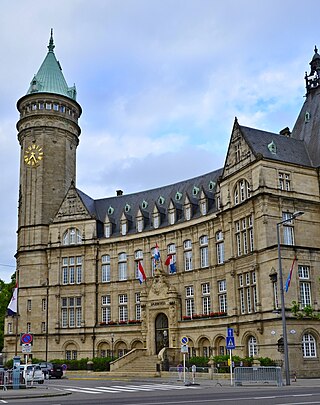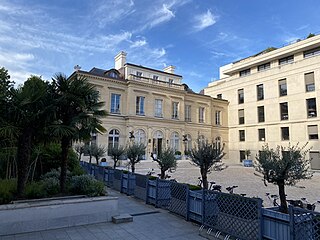
Jacques Laffitte was a leading French banker, governor of the Bank of France (1814–1820) and liberal member of the Chamber of Deputies during the Bourbon Restoration and July Monarchy. He was an important figure in the development of new banking techniques during the early stages of industrialization in France. In politics, he played a decisive role during the Revolution of 1830 that brought Louis-Philippe, the duc d'Orléans, to the throne, replacing the unpopular Bourbon king Charles X.

Banque Cantonale de Genève (BCGE) is a limited company established under Swiss public law, resulting from the merger of the Caisse d'Épargne de la République et Canton de Genève and the Banque Hypothécaire du Canton de Genève. It is one of the 24 cantonal banks.

Banque Populaire was a French group of cooperative banks, with origins in the European cooperative movement. In 2009, it merged with Groupe Caisse d'Épargne to form Groupe BPCE.

Groupe Caisse d'épargne was a group of French savings banks that were converted into cooperative banks by legislation enacted in 1999. Its roots went back to the founding in 1818 of the Caisse d'Épargne et de Prévoyance de Paris, initiated by Benjamin Delessert and the Duke of La Rochefoucauld-Liancourt.

The State Bank and Savings Bank, also known by its Luxembourgish name Spuerkeess, is the leading national financial institution founded in 1856 and governed by the law of 24 March 1989. Spuerkeess is a commercial bank wholly owned by the government of Luxembourg.

The Caisse des dépôts et consignations is an idiosyncratic French public financial institution created in 1816, often referred to as the investment arm of the French State. It is defined in the French Monetary and Financial Code as a "public group serving the public interest" and a "long-term investor". Its governance framework places it under the control of the Parliament.

Hottinger Group is an international wealth management business headquartered in London providing family office, Investment banking and other associated financial services. Hottinger is known as one of the first private banks, created on 1 August 1786 by the Hottinguer family.
The banking industry in France has, as of 11 October 2008, an average leverage ratio of 28 to 1, and its short-term liabilities are equal to 60% of the French GDP or 128% of its national debt.

Groupe BPCE is a major French banking group formed by the 2009 merger of two major retail banking groups, Groupe Caisse d'Épargne and Groupe Banque Populaire. As of 2021, it was France's fourth largest bank, the seventh largest in Europe, and the nineteenth in the world by total assets. It has more than 8,200 branches nationwide under their respective brand names serving nearly 150 million customers. Its wholesale banking subsidiary Natixis, previously a separately listed company, was delisted and came under full ownership of Groupe BPCE in 2021.

Crédit Mutuel is a French cooperative banking group, one of the country's top five banks with over 30 million customers. It traces its origins back to the German cooperative movement inspired by Friedrich Wilhelm Raiffeisen in Alsace–Lorraine under German rule, in the 1880s. Crédit Mutuel was a member of the International Raiffeisen Union (IRU).

François Pérol is a French banker and high-ranking official and is the current chairman of Natixis.
Nicolas Mérindol, is a French Business executive who was the former CEO of the Groupe Caisse d'Épargne. Since July 2012 he has been the Chairman and Partner of Amilton, a financial services group.

Nagelmackers is a private bank in Belgium, the oldest in the country and the 14th oldest surviving bank in the world. It focuses on wealthy individuals and families, relying on a network of local offices. In July 2024, It was purchased from China's Anbang by Caisse d'Epargne Hauts de France, a local bank of Groupe BPCE in the Northern French region.

ODDO BHF is an independent Franco-German financial services group. It was created from the alliance of a French family-owned business built up by five generations of stockbrokers and a German bank specialising in Mittelstand companies. ODDO BHF operates in three main businesses: private banking, asset management, and corporate and investment banking.

Philippe Oddo is a French financier and a managing partner of the ODDO BHF group.
Ostrum Asset Management, is a French asset management company that was founded in 2007. The company is part of French banking group BPCE. Ostrum Asset Management is an affiliate of Natixis Investment Managers, majority owned by BPCE.
BRED is one of the cooperative banks part of Groupe Banque Populaire in France. It was founded in 1919 by Louis-Alexandre Dagot in Vincennes. As of 2018, the Bank has a network of 400 local branches in France. 30% of its 6,600 employees are located outside France and in French overseas collectivities. It has 5.8 billion euros of shareholders equity.

The Crédit national was a French government-sponsored bank, created in 1919 on the initiative of senior civil servant Charles Laurent. It eventually merged in 1996 with Banque Française du Commerce Extérieur (BFCE) to form Natexis, later absorbed into Groupe BPCE.

Éric Lombard, born May 16, 1958, in Boulogne-Billancourt, is a French business leader. Director of BNP Paribas Cardif from 2004 to 2013 then CEO of Generali France from 2013 to 2017, he has been CEO of the Caisse des dépôts et consignations since December 8, 2017.
Laurent Mignon is an investment banker and current chairman of the management board of Wendel.
















